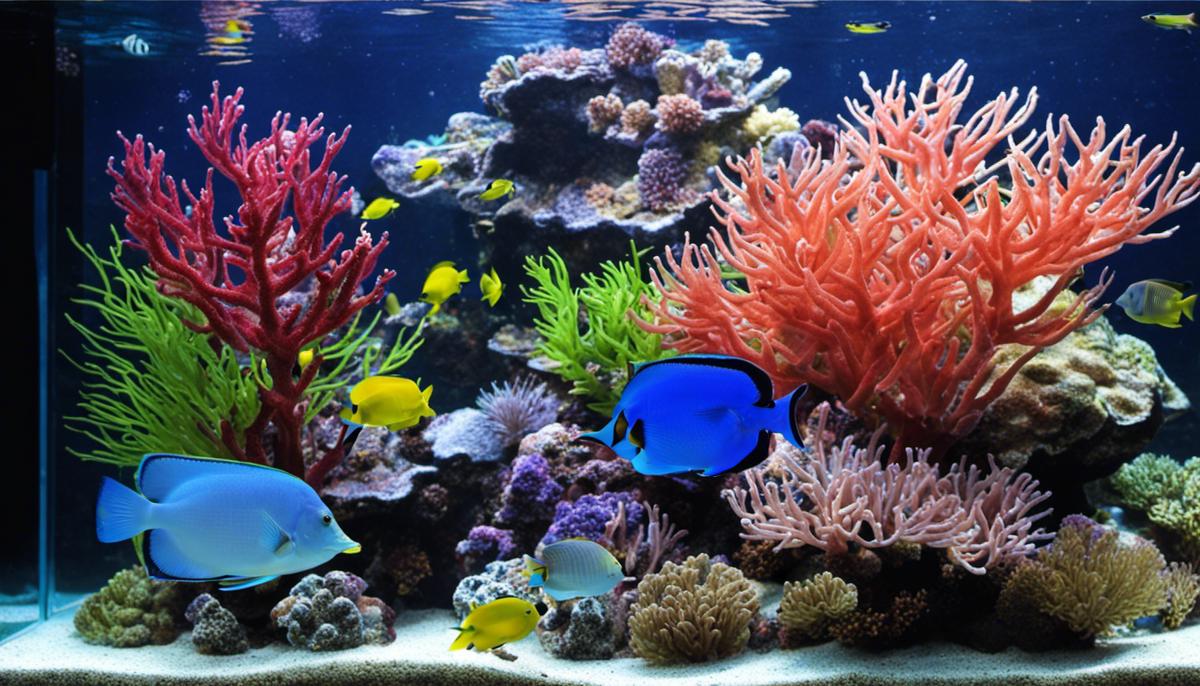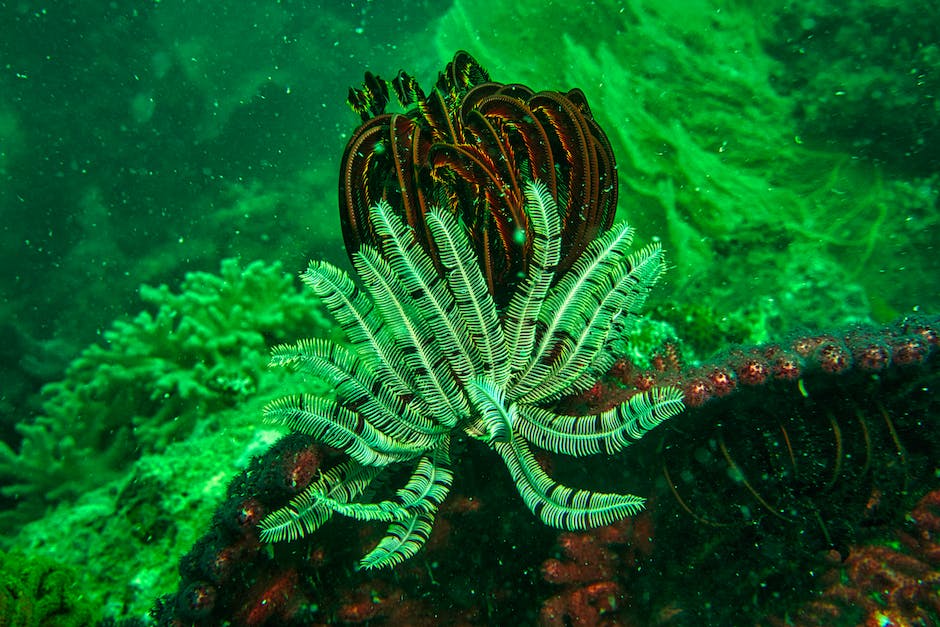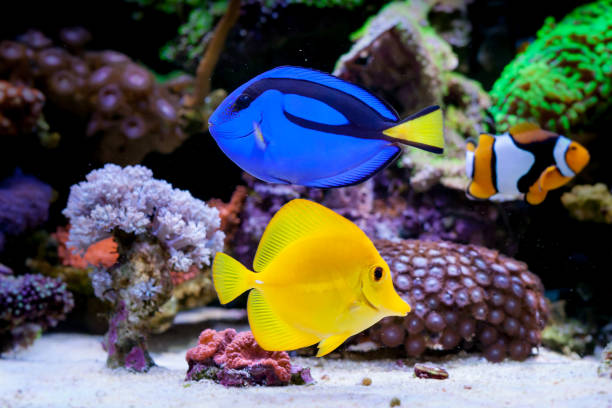Navigating the complex world of saltwater aquariums can be both a fascinating and challenging journey. One of the vital components of this journey involves understanding the crucial role of water chemistry and how to effectively use additives to simulate a natural marine environment. Correctly balanced water parameters – such as salinity, pH, alkalinity, and temperature – are essential for a thriving underwater ecosystem. This knowledge isn’t yet another obscure scientific concept; instead, it lies at the heart of saltwater aquarium-keeping, determining the health and growth of corals, fish, and other invertebrates. Our exploration will also include an overview of the numerous additives commonly used within saltwater aquariums, an evaluation of their pros and cons, and provide insights into the administration and monitoring of these additives to ensure optimal water quality.
Understanding Water Chemistry in Saltwater Aquariums
Understanding Water Chemistry in Saltwater Aquariums
When maintaining a saltwater aquarium, the water’s chemistry is of the utmost importance. It is crucial to understand the role of various components such as salinity, pH, alkalinity, and temperature within the aquarium ecosystem.
Salinity
Salinity is a crucial aspect of a saltwater aquarium, affecting both the fish and invertebrates in a tank. The salinity of ocean water is typically 35 parts per thousand (ppt), and this is a good target to aim for in a saltwater aquarium. While it’s cardinal to replicate the natural marine environment, variances in water condition may cause stress and risk to your marine life. Hence, saltwater aquariums often require additives known as marine salts to maintain the right salinity.
pH
The pH of the water represents how acidic or alkaline it is. Saltwater fish thrive in slightly alkaline water with a pH of around 8.1 to 8.4. This is where pH-balancing salts or buffers come into play. These additives help maintain the ideal pH level, providing a stable environment for marine life forms.
Alkalinity
Alkalinity is the measure of the water’s capacity to neutralize acids. In a saltwater aquarium, maintaining an alkalinity of around 8-12 dKH (2.8-4.3 meq/L) is considered ideal. Additives, such as bicarbonates, carbonates, and certain borates can be used to control and maintain alkalinity. While it might sound very similar to pH, the two are different. Alkalinity is about the water’s ability to resist changes in pH.
Temperature
Temperature is another important aspect of a saltwater aquarium. Most saltwater aquarium inhabitants prefer a temperature range of 72 to 78 degrees Fahrenheit. Therefore, some form of heating or cooling may be necessary according to seasonal changes, and thermostatic control is essential to ensure a stable temperature environment.
Other Minerals and Nutrients
Apart from these primary components, there are several other minerals and nutrients that the marine life in your aquarium will need to survive and thrive. These include calcium, magnesium, iodine, and several trace elements. Calcium is necessary for coral and some invertebrates to grow their shells or skeletons. Magnesium interacts with the alkalinity and calcium in your tank to keep balance. Iodine is used by many organisms, including corals and algae. Regularly adding these elements is necessary to replenish the resources your fish, corals, and invertebrates need to flourish.
Regular Testing
Another essential aspect of maintaining a successful saltwater aquarium is regular testing of water parameters. Over time, food, waste, and other organic material can break down in the water, creating toxins. Regular water changes and testing for ammonia, nitrite, and nitrate will ensure a healthy environment for your aquarium inhabitants.
Final Words
Maintaining a balanced marine ecosystem within your aquarium relies heavily on the correct balance of specific elements. Your understanding and application of these parameters are vital to promoting the health and well-being of your captive marine creatures.

Types of Additives for Saltwater Aquariums
Importance of Calcium Additives
Calcium holds a crucial role among the commonly used saltwater aquarium additives. This element greatly aids in the skeletal development of the corals and other marine invertebrates. Absence of enough calcium results in poor growth of these marine creatures. Kalkwasser and the Two-Part Calcium and Alkalinity supplements are among the highly-rated calcium additives available to take up this critical role. Regular and adequate application of these supplements ensures your aquarium is populated with healthy, growing corals and invertebrates.
Alkalinity Additives
Alkalinity additives are essential to balance the water chemistry in a saltwater aquarium. They work by absorbing acidic elements in the water and hence preventing a drastic pH swing. Stabilizing the alkalinity level is key to sustained coral health because major dips and spikes can disrupt the biological processes of marine dwellers and cause them stress. Like calcium additives, Two-Part Calcium and Alkalinity supplements are a common choice among aquarists for addressing this need.
pH Boosters
pH is a measure of our aquarium water’s acidity or alkalinity on a scale from 0 (very acidic) to 14 (very alkaline) with 7 being neutral. Ideally, a saltwater aquarium should maintain a pH near to 8.3 for optimal health of marine life. When pH becomes too low (acidic), marine animals can undergo stress, which can lead to disease and, potentially, death. pH boosters are used to increase and stabilize the pH level when its natural balance is disturbed. Some examples of pH boosters include Seachem Marine Buffer and Two Little Fishies pH Balance.
Trace Element Additives
Besides the core elements like calcium and alkalinity, a saltwater aquarium also needs smaller quantities of trace elements. These contribute to the coloration, health, and metabolic functions of the various marine dwellers. These trace elements include iodine, strontium, molybdenum, and iron among others. They usually get depleted from the aquarium water due to ongoing biological processes and hence need replenishing. For instance, iodine boosts the blue/purple colors in corals while strontium helps in their skeletal formation. To ensure the presence of these essential trace elements, aquarists may use commercial trace element mixes.
Magnesium Additives
Magnesium, though not very glamorous, is an essential additive for a well-maintained saltwater aquarium. Magnesium serves to keep calcium and alkalinity in balance; without it, the levels of these elements may fluctuate uncontrollably. It is important to maintain the magnesium concentration at appropriate levels to ensure that the corals and invertebrates can optimally utilize the calcium and alkalinity in the water. Magnesium additives like Kent Marine Tech M Magnesium can be used for this purpose.
Preserving a balanced and stable distribution of additives in your saltwater aquarium brings forth an ideal environment for your marine life to flourish.

Choosing the Right Additives: Pros and Cons
The Importance of Knowing Saltwater Aquarium Additives
Additives in saltwater aquariums act as vital supplements, replenishing necessary nutrients, imitating natural sea conditions, and correcting discrepancies in aquatic chemistry. Comprehending the diverse range of these additives, their advantages, disadvantages, and the potential effects they may cause, enables you to choose the most appropriate ones for your marine sanctuary.
Types of Additives
Additives can be organic or inorganic, based on their chemical compositions.
Organic additives include amino acids, vitamins, and other organic molecules that marine organisms need for growth and health. For example, vitamin C boosts the immune system of fish, while amino acids support coral health.
Inorganic additives, on the other hand, are essential elements and compounds like calcium, magnesium, and buffer solutions necessary for the marine life in your aquarium. Calcium and magnesium are critical for the growth and calcification of corals, while buffer solutions help maintain a stable pH level in the water.
Benefits of Additives
The primary benefit of using additives is to provide a balanced, nutritious environment for the inhabitants of your aquarium. Proper use of these substances ensures the growth and health of the aquarium life forms. For example, adding trace elements like iron, iodine, and strontium promotes healthy coral growth and coloration.
In aquariums void of these vital elements, the vitality, growth, or color of corals may diminish. Similarly, the right balance of alkalinity, calcium, and magnesium creates ideal conditions for coral calcification, essential for growth.
Risks and Repercussions
While additives can be beneficial, there are potential risks if misused. Adding too much of an element can lead to an imbalance in water chemistry. For instance, excessive calcium can increase the water’s hardness, inhibiting the growth of certain marine life.
Moreover, certain elements, when overdosed, can be toxic to the aquarium inhabitants. Excess copper can be harmful or fatal to many invertebrates, while high concentrations of iodine may hinder coral growth. Therefore, it’s important to use the correct dosage, considering the size and needs of the aquarium, to avoid adverse effects.
Finally, continued reliance on additives without adequate water changes can lead to a buildup of pollutants and unwanted elements in the aquarium, negatively affecting the water quality and the health of the aquarium occupants.
Maintaining the Balance
The primary essence of preserving a flourishing saltwater aquarium is maintaining a delicate balance. Although additives play an instrumental role, their use must coincide with standard water changes and frequent testing. Moreover, it’s also imperative to understand the unique requirements of your aquarium residents and adjust the use of additives accordingly, to ensure a robust, thriving marine ecosystem.

Administering Additives and Monitoring Water Quality
Maintaining a vibrant saltwater aquarium requires careful management of varying additives. These additives are essential for replenishing vital nutrients and promoting the desirable water conditions necessary for nurturing marine life.
The most significant additives generally used in saltwater aquariums consist of calcium, magnesium, and supplements for alkalinity. These components are indispensable for the wellbeing of corals and various invertebrates as they utilize them for constructing their outer skeletons.
Calcium supplements are typically added daily, aiming for a target concentration of approximately 380-450 parts per million (ppm). Likewise, the prescribed range for magnesium levels in a balanced saltwater aquarium should be between 1250 and 1350 ppm.
On the other hand, alkalinity focuses on the water’s ability to neutralize acids, predominantly affecting pH stability. Typically, alkalinity supplements are incorporated weekly, with the aim of attaining 8-12 dkh.
As a rule of thumb, additives should be gradually included and distributed throughout the day to prevent sudden variations in water chemistry. Complying with the manufacturer’s instructions regarding the quantity and regularity of use is crucial.
Regular testing of water quality is imperative in maintaining a healthy marine environment. Various testing tools, like test kits and electronic monitors, are available to measure different parameters.
Test kits usually comprise reagents that react with water samples to indicate concentration levels of various substances. Electronic monitors provide digital readings for more accurate and convenient monitoring.
Primary water parameters to watch include temperature, pH, salinity, ammonia, nitrates, nitrites, phosphate, calcium, alkalinity, and magnesium.
Controlling temperature is vital. A consistent temperature of around 78-82 degrees Fahrenheit (25-28 degrees Celsius) is suitable for most marine organisms. The pH should be within 8.1 to 8.4, representing a balanced marine environment.
Nitrate levels should remain below 1 ppm for reef tanks and under 20 ppm for fish-only tanks. Increased nitrate levels can lead to algae blooms and negatively impact fish health.
Ammonia and nitrites are toxic to fish, even at relatively low concentrations, with optimal levels being zero.
Accurate interpretation of test results helps in determining whether additive administration needs to be adjusted.
For instance, low calcium, magnesium, or alkalinity levels indicate that the aquarium inhabitants are consuming these elements faster than they are being replenished. This scenario might require an increase in the dose or frequency of the corresponding additive.
On the other hand, consistently high readings of these substances may suggest that the aquarium’s bioload (the capacity of life the aquarium can support) is too small for the amount of additive being added. This hints at the need to decrease the additive dose.
Similarly, high nitrate levels may be a signal for reduced feeding or better tank cleaning rather than a deficiency in additives.
Thus, monitoring test results assists in maintaining the balance of additives and ensuring a thriving saltwater aquarium.

Stepping into the realm of saltwater aquariums demands knowledge, passion, and an understanding of the artificial marine world you are bringing to life. The journey involves more than just selecting vibrant fish and attractive corals; it calls for a deep understanding of the intricate water chemistry and the role of additives in creating a balanced ecosystem. Making an informed decision about the various additives, their administration, and the monitoring of water quality may seem like a daunting task, but it is an enriching and rewarding endeavor. It is through these small yet significant steps that your saltwater aquarium will not only survive but thrive, providing a riveting spectacle of underwater life right within your home or office.
ChasingNemo.com is a participant in the Amazon Services LLC Some of the links in our posts are affiliate links. Click Here For Full Disclosure.







